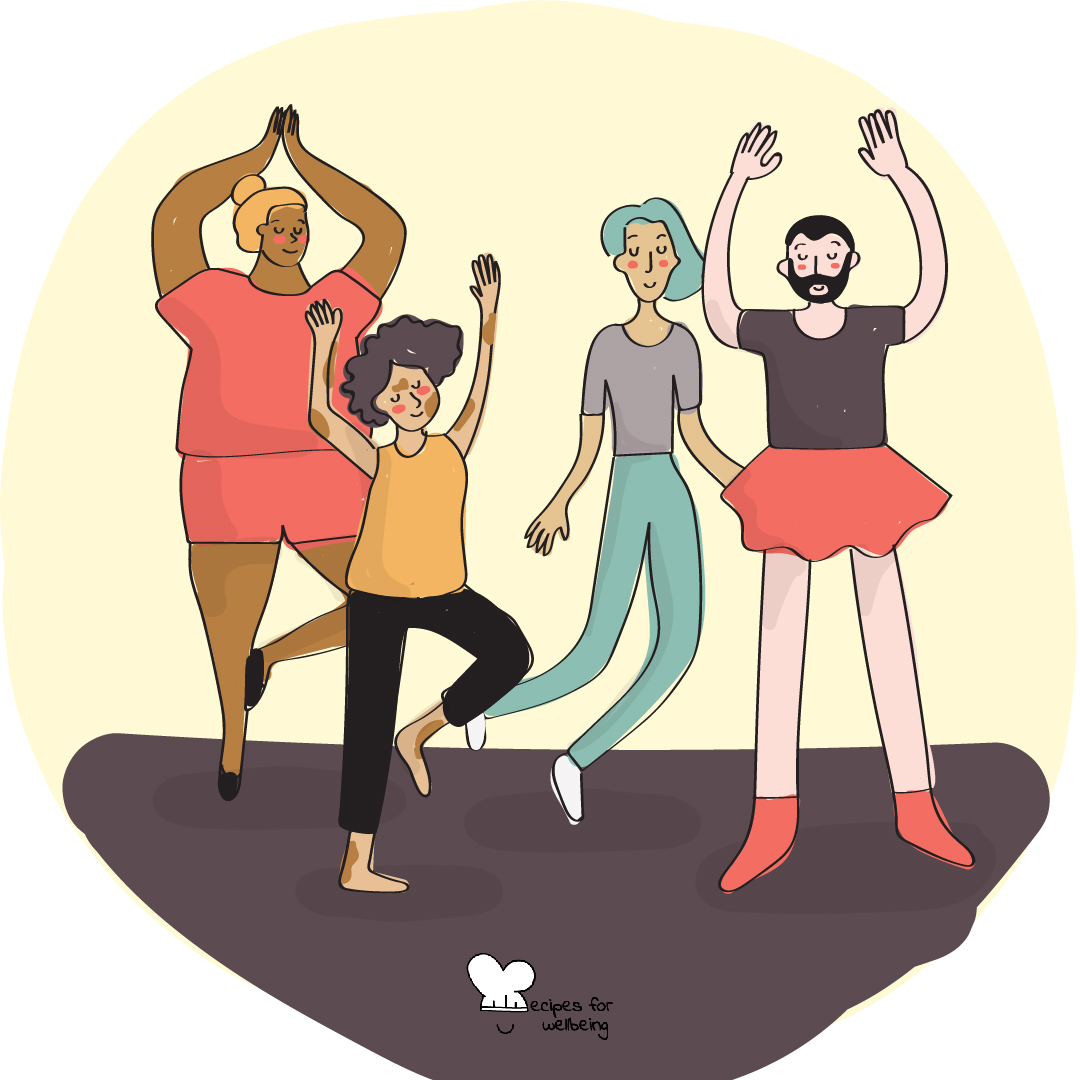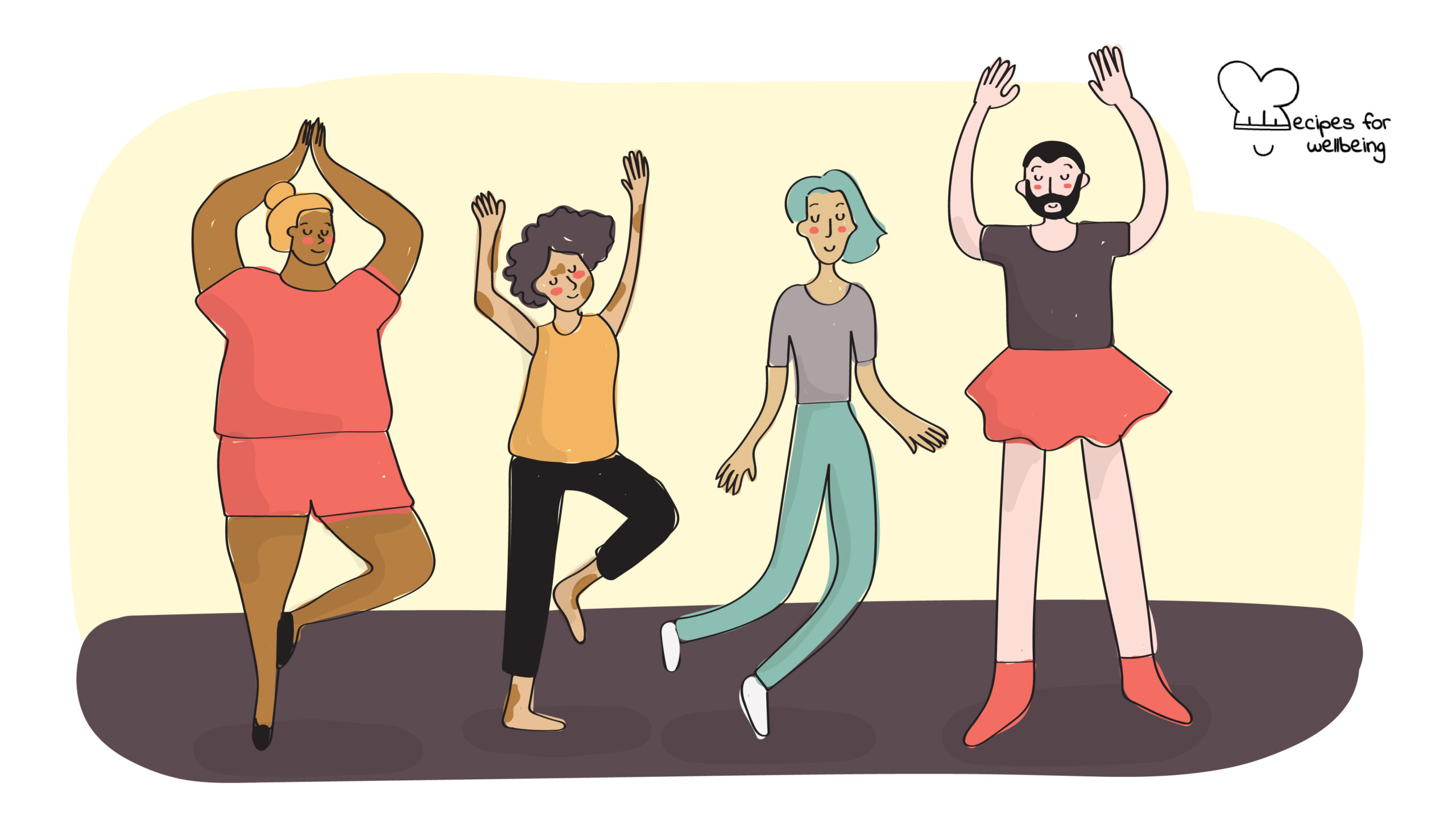
Practising body neutrality
This body has carried me through a hard life. It looked exactly the way it was supposed to. ―Veronica Roth
👥 Serves: 1 person
🎚 Difficulty: Medium
⏳ Total time: 5 minutes to 1 hour
🥣 Ingredients: A journal, a couple of small snacks, comfortable sports clothes (the ingredients depend on which activity you opt for)
💪 Nutritional values: Peace, Self-acceptance, Confidence, Joy, Appreciation

Practising body neutrality
📝 Description
Learn to practise body neutrality.
Have you heard of the body positivity movement? This movement is on a mission to challenge society’s obsession with appearance and its rigid definition of beauty (read: white, petite, able-bodied) and instead focus on the beauty of diversity. It is an important mission rooted in acceptance, self-acceptance, and confidence. If you are curious to practise body positivity, try out our recipe “Affirmations for body positivity”.
Yet, body positivity is not always accessible to everyone and includes many variables based on individual experiences and opportunities. Body positivity doesn’t work for everyone, for a number of reasons, and it doesn’t make you a bad person for not being there – nor does it make you a bad person for being there. Everyone is on their journey.
If you find body positivity overwhelming, try practising body neutrality.
Body neutrality strives to unlink physical appearance from self-worth and instead focus on health and appreciating your body for its non-physical properties. Having a neutral mindset permits you to remove the expectation that you “have to” love yourself every day.
Even if you do not realise it, subconsciously you may hold onto assumptions about body image that have been passed on, experienced, witnessed and/or learnt since childhood. For example, every rude comment about weight gain or weight loss, every unrealistic body in the media, every discussion about valuing certain bodies over others – have a way of forming your opinion of yourself. This can be exhausting, and why body neutrality might be the best approach to finding peace in your journey.
It is important to note that body neutrality is not “better” than body positivity: they are both useful depending on where you are on your journey.
This recipe has been created by our wellbeing content writer collaborator Marissa Del Mistro.
👣 Steps
Step 1 – Practising affirmations (5’)
Body neutrally won’t happen overnight! The way you speak to yourself is so important and you will want to aim to form your thoughts around the functionality of your body. Affirmation is one of the best ways to try this. Affirmations that you can say aloud or quietly to yourself include:
- I am allowed to rest.
- My arms allow me to hug my loved ones, which are special and important to me.
- I respect my body.
- My thighs and legs allow me to explore my favourite places.
- My body belongs.
- My body cares for me, and I will care for my body.
- My body is worthy.
- My legs and arms allow me to dance.
- People enjoy being around me and enjoy my presence.
If affirmations feel like too much, when you wake up in the morning, take a moment to say thank you to your body that has allowed you to rest.
Step 2 – Mindful eating (5’)
Mindful eating invites you to stay present when enjoying food and drink. It asks you to observe how the food makes you feel, and the signals your body sends about taste, satisfaction, and fullness. Mindful eating requires you to simply acknowledge and accept rather than judge the feelings, thoughts, and bodily sensations you observe.
Mindful eating is not about having strict rules about calories, or which foods you have to include or avoid. Eating mindfully can help with:
- Slowing down and easing stress and anxiety,
- Derive greater pleasure from the food you eat,
- Make healthier choices about what you eat,
- Improve your digestion,
- A deeper understanding of where your food comes from, how it is produced, and the journey it has taken to your plate, and
- Eat in a more balanced way.
Check out our recipes “Mindful eating” and “Raisin meditation” for step-by-step guidance.
Step 3 – Writing a gratitude letter to yourself (30’)
Take time to write a letter to the body that carries you through life. In the letter, thank your body for what it allows you to do every day, what challenges it has carried you through, what it has overcome. For example: Has your body overcome illness? Carried children? Healed from a broken bone? Express gratitude for all that it does.
Step 4 – Moving for pleasure, not punishment (30’–60’)
Exercising and moving your body is an important aspect of staying healthy. It should be a way to celebrate the things your body can do. Exercise and movement as a celebration increases joy, contentment, and gratitude for life. For people who find a routine and movement that is fun and enjoyable, it is easier to look forward to these sessions and ensure consistency in your routine.
Examples of movement for fun and enjoyment can be:
- A dance class
- Swimming
- A long walk
- A yoga class (check out our recipes “Chair yoga”, “Gentle morning flow”, “Immune sequence (morning)”, “Morning yoga routine”, and “Sun salutation” for home practices)
- Paddle boarding
- Climbing
- Kayaking
- Hiking
- Stretching

